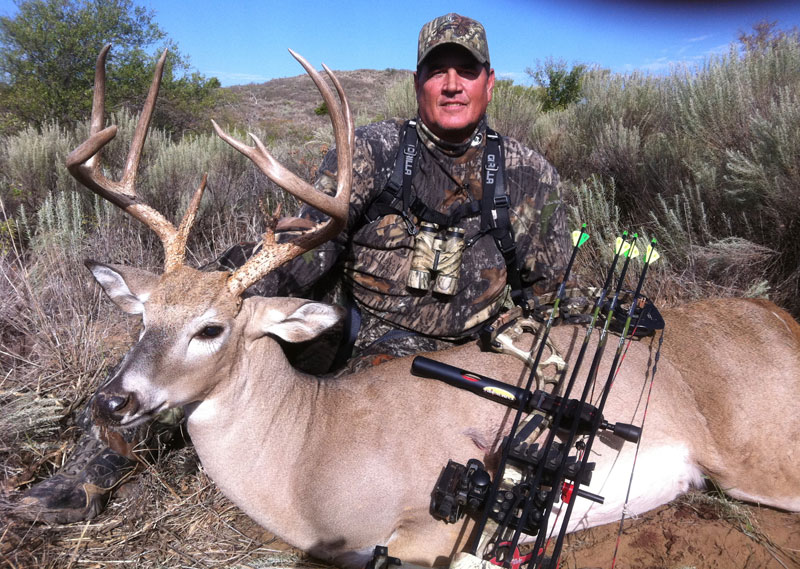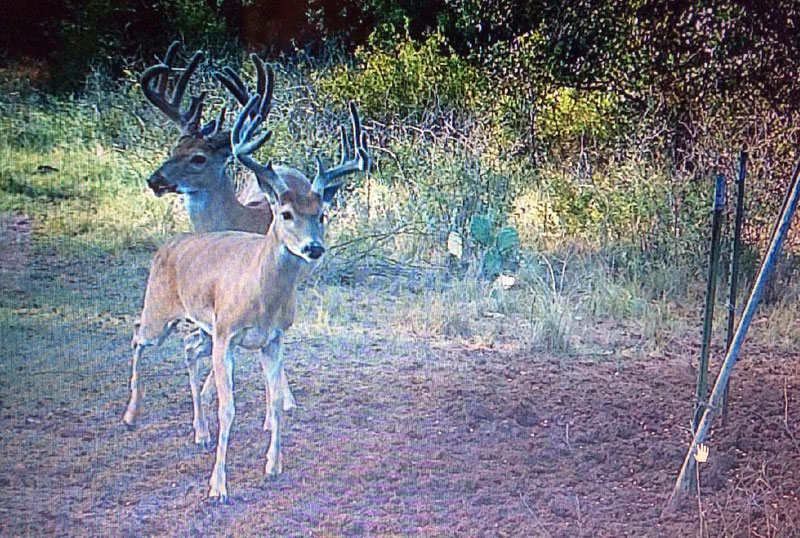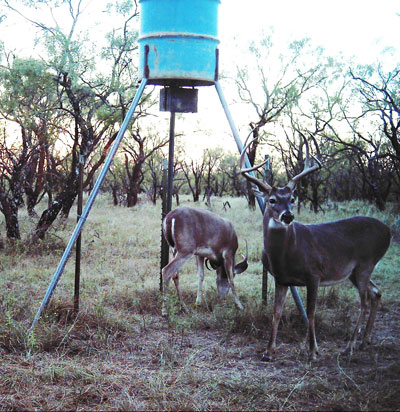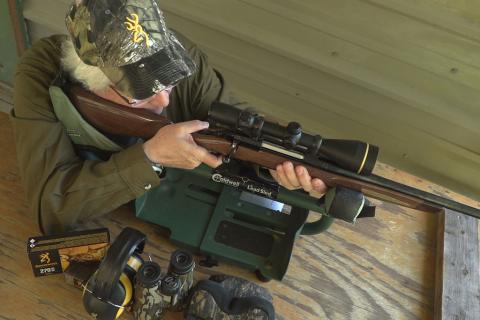Kevin Burleson owns Heart of Texas Bowhunting, in central Texas. Burleson’s bowhunting for deer always begins the closest Saturday to September 30th each year. The weather is hot then, and you probably won’t think that bowhunting will be very productive. However, on the more than 20,000 acres Burleson has to hunt, there’s plenty of deer. Baiting deer is legal in Texas.
Bowhunting Wild Hogs and White-Tailed Bucks for Three Days

The week before bow season arrived here in central Texas in 2018, we had 90-plus degree weather. In the early season, I’ve learned that the full moon is a bad time to hunt deer here. Opening weekend of the 2018 deer season had a full moon. The third problem hunters had was that this section of the state had a bumper crop of acorns. So, just about everywhere a hunter put his foot, he stepped on acorns. The acorns here are just like corn; the deer treat them like candy. So, trying to attract the deer to corn we had out would be tough, I knew.
We had 18 bowhunters for opening weekend. The good news was that we had a very healthy population of wild hogs where we were hunting. More good news was that the ranches we were hunting this year hadn’t leased their lands for hunting for 15 years. So, everything on those properties was unchecked and unmanaged. We could offer a target-rich environment for wild hogs as well as for white-tailed deer. The first morning of our 2018 hunt, our bowhunters took 12 feral hogs.
We operate a 3-day, do-it-yourself hunt every weekend at Heart of Texas Bowhunting. I show each hunter the deer’s feeding and bedding areas. Then the hunters set up their own tree stands or ground blinds and hunt the land the way they want to hunt it. To make those hunts interesting, we have a Big Boar Pot, a Big Sow Pot and a Total Number of Wild Pigs Harvested Pot. So, we give our bowhunters incentives to harvest hogs as well as take deer.
These 3-day, do-it-yourself hunters hunt Friday, Saturday and Sunday. By the end of those 3-day hunts, the 2018 hunters had taken 38 wild hogs. The biggest hog taken weighed 297 pounds and was a sow. The biggest boar taken this year weighed over 260 pounds. To harvest that boar, our bowhunter shot three times and then finished off the boar with a big knife. The bowhunter’s first shot spined the wild boar. The bowhunter walked in close and shot the boar two more times, to Ensure that hog was down. However, when the bowhunter walked close, the boar still was snapping his jaws and showing his ivories. The bowhunter pulled out a knife that resembled a half-knife and a half-machete and dispatched the wild boar. The bowhunter taking the most for the 3-day hunt brought in six wild hogs. We could have taken more wild hogs, but some of our hunters felt that if they shot hogs, they wouldn’t have as a good chance on deer. So, some of the bowhunters never took shots at wild hogs.
If a bowhunter comes to Heart of Texas Bowhunting to take wild hogs, he or she should have the opportunity to harvest 10 animals in three days. We also had three good bucks come in during this first week of deer season, two nice 8-pointers and a really nice 11-pointer.
Deciding When to Shoot and Not Shoot Texas Deer
In a 3-day hunt on opening weekend of Texas’s 2018 bow season, one of our bowhunters took an 11-point buck that scored 176-6/8 Pope & Young. An 8-pointer harvested scored just under 130, and another 8-pointer scored 122. I manage this property by designating the bucks that are harvested have to be a minimum of 120 inches or be at least 4-1/2-years old as an 8-pointer or 5-1/2-years old for a 10-pointer or older. Aging a deer in the field is difficult, especially for hunters from other states and not from Texas. If a hunter wants to shoot a deer that’s 5-1/2-years old, then regardless of that buck’s rack, the hunter still has to send me a photo of the buck he wants to shoot before taking the buck. The reason for that is because a 5-1/2-year-old buck on the land where we hunt may look entirely different from a 5-1/2-year-old buck taken in another state.
Deer usually come in to feed – often not more than 20-25 yards – from the bowhunter’s stand. So, the hunter has time to shoot a photo of the buck with his cell phone camera and text it to me. Then I can text back either “shoot,” or “don’t shoot.” Our average shot is 15-17 yards. The hunters can’t hunt over or near any of the automatic feeders we have set out and must establish their hunting areas by going to a feeder and walking off 150 yards from that feeder before setting up. Usually there will be a trail going to the feeder, so the hunter will be in-between the bedding area and the feeding area when he takes his shot.
Our Texas deer react quickly to the sound of a bowstring. They can drop and then jump almost before you can blink your eye. That’s why we suggest that our hunters not take shots at more than 25 yards away from a buck and preferably at less than 20 yards. Shots over 25 yards historically have not produced bucks in our region. Once a deer is further than 25 yards from the shooter, we often have problems with that deer being shot but not recovered.
If the hunter doesn’t take the shot at a buck but brings me a photo back of the buck he had the opportunity to shoot, I’ll look at the buck’s photo and see he’s 5-1/2-years old or older. Then I’ll give the hunter the green light to take that buck, if he sees the buck on his next hunt. That’s why we can manage our deer herd without using guides to sit with every hunter and tell the hunter which bucks he can and can’t shoot.
Learning the Importance of Keeping Hunting Pressure off Deer

Our deer season in central Texas begins around the first week in October and runs through the first full weekend in January. Our hunters come in on Thursdays, set up their tree stands in the regions where they’ll be hunting and hunt Friday, Saturday and Sunday. Each hunter must have all his gear out of his hunting area by Sunday night. Right now I have about 39 feeders operating, but before the end of the season, I’ll have 50-55 feeders set up on our lands.
Usually our hunters will put out two or three game cameras each. So, every week of the season, I receive good recon on what’s on each part of our land and how patternable the deer are. We also rotate our hunters every weekend, depending on what the previous hunters have seen or not seen. Something I like about using feeders is that the feeders enable us to predict when deer will move. This reason is why our hunters usually see numbers of deer and wild hogs and have a good chance of taking nice bucks with their bows. We also have learned that if you don’t hunt near a feeder continuously, then that feeder doesn’t represent a danger zone for the deer. The deer can come to a feeder all day. Those deer know that birds, squirrels and the wind will knock corn out of the feeder all day, even if the feeders aren’t running. Often we’ll have deer show up at feeders in the middle of the day because they feel safe there at that time. They’re not being shot at when they’re at the feeder.
By keeping my hunters 150-200 yards away from the feeder, then deer will move for a good portion of the day. Deer become nocturnal when they’re aware of hunters hunting them and the places where they’re being hunted and will remain where the hunters aren’t hunting them. When you don’t put hunting pressure in an area where there’s a feeder, there’s no reason for the deer not to come to the feeder at all times of the day, whether food is there or not. The feeder area actually is a deer sanctuary.
All of my feeders are numbered. Every day I have a number on a chip for each place my hunters are hunting. I’ll put those chips into a can, and at the end of the day, I’ll pull the chip out of the can and go and check to make sure no hunter is close to the feeder. So, hunters never know when their numbers will come up, and I’ll be checking how close they’re hunting to feeders. 2018 is my 17th year in guiding hunters, and only once have I had to scold a hunter for hunting too close to a feeder. Since two hunters have 350-500 acres to hunt, there’s plenty of room for a hunter to determine where to set up that will be more than well away from the feeder. We have two hunters per area, which means they all have an abundance of room to set-up and hunt.
Another advantage our hunters have here at our place is that we have very strict rules about when they can and can’t drive on our property. Most of the pastures where our hunters hunt, they can’t drive into them. They must park on the outside of the pasture and walk in to where they’ll be hunting. Another rule is that a hunter can’t drive a vehicle from 30 minutes before daylight until 10 a.m. anywhere on our lands. They also can’t start their vehicles or drive them from 4 p.m. until after dark. So, no vehicle movement is on our property during the deer’s peak movement times. Each one of our areas is a virtual sanctuary for deer.
Our hunters generally reach their blinds about an hour before daylight and don’t leave their blinds until an hour after dark. With this method, the deer shouldn’t ever see a hunter during daylight hours. On most leased land in Texas, hunters usually will sit in their blinds until 8 a.m., and if they don’t spot any deer, they’ll jump in their trucks and drive around for three hours or so. We see the deer numbers on the properties we hunt increase drastically during deer season. We do everything we can to keep the deer from seeing or hearing our hunters during daylight hours. The properties’ hunters around us often do just the opposite.
Understanding Why We Hunt the Way We Do
 Our best buck ever was a 34-point buck that scored more than 190 on Pope & Young. This deer had a lot of palmation and numbers of points and was difficult to score. All of our deer are low fence, free-range deer. We harvest bucks that will score in the 150s and 160s P&Y each year. Already in 2018, at this writing in mid-October, we have two bucks on trail cameras that will score 160 or more. The hunter who took a buck on opening weekend that scored 147 saw one of the bucks over 160. However, the buck stayed out at 50 yards and never came in any closer.
Our best buck ever was a 34-point buck that scored more than 190 on Pope & Young. This deer had a lot of palmation and numbers of points and was difficult to score. All of our deer are low fence, free-range deer. We harvest bucks that will score in the 150s and 160s P&Y each year. Already in 2018, at this writing in mid-October, we have two bucks on trail cameras that will score 160 or more. The hunter who took a buck on opening weekend that scored 147 saw one of the bucks over 160. However, the buck stayed out at 50 yards and never came in any closer.
The reason we hold our hunts at Heart of Texas Bowhunting the way we do is because I’ve been bowhunting all across the U.S. and in Canada. In most of these places where I’ve hunted, I have to sit in a blind the outfitter has set up. Plenty of times I’ve seen deer movement on a far ridge and wished that I had the freedom to move out of my stand and go and set up a blind or get into a tree stand on the ridge where the deer are moving. But I can’t do that due to the outfitter’s not having a blind set up in that area and my not being able to move. Another problem I’ve encountered is that on most of the places where the outfitter puts hunters, it’s in the same stands he’s used for other hunters for several years. Therefore, the deer know where the hunters have been before.
We set up our hunts so that the hunters can put up their stands anywhere they wish within that 300-500 acres that no one but them hunts. We’re not conditioning our deer to know exactly where our stands are, which keeps them from getting downwind of the stands, realizing that hunters are there and walking around those stands out of bow range. This practice helps us take very nice deer each year. Each hunter gets to decide where he wants to put his stand every weekend.
Taking big deer means doing many little things correctly. We attempt to do as many of the small things for success as we can on each hunt. For instance, if a hunter sees deer moving, 50-60 yards from where he’s set up his stand, he can move his stand to be closer to where he’s seeing the deer and thinks he can get a shot. We also have to consider the weather. When that hunter has set up his stand, he may have set it up to hunt a southwest wind, yet when he gets up the next morning, the wind is coming from the northwest. So, he can set up his stand again, wherever he feels he’ll get the best shot at a deer.
Each hunter can put out his own corn on our hunts. We know from experience that young bucks and does will come in to that corn quickly. But when an older buck discovers corn where there’s never been corn before, he’ll be more reluctant to come in to that corn. The older bucks will watch those young bucks and does. Once they see the does and young bucks feeding on the corn, they’ll build up their confidence and perhaps come in later in the hunt. I’m not saying that some of our hunters go out on the first day and take nice bucks then. Sometimes that does happen. However, a hunter’s odds for success increase as long as his corn is in the same place for at least a day or two. Some hunters do move their stands. Many other hunters won’t move their stands.
Mistakes Bowhunters Make at the First of Deer Season
At the first of bow season, especially in the South, we’ll have hot weather in Texas. That’s why most of our blinds are ground blinds. When you set up one of those tent ground blinds that has a roof on it, that tent becomes like an Easy Bake Oven. Most hunters who have hunted with us in the past have learned that those small battery-powered fans that you can buy at most carnivals and fairs can be life savers in that weather at the first of deer season. They also know that the more you sweat, the more human odor you produce. The biggest way to prevent human odor from spooking your deer is to have your blind set up properly. I personally don’t like the pop-up blinds that have Velcro on the windows to keep them shut. Human odor can seep through that Velcro easily. The blinds with overlapping windows contain your human odor much better.
We recommend that our hunters put their blinds up so that they’re very tight and then cover the bottom of the blinds on the outside all the way around the bottoms with dirt and only have one opening (window) about 6 inches wide and 8 inches tall to use to shoot. Then you can better contain your scent inside that blind. Also using Ozonics inside the blind will help you be 80-85% more effective bowhunting than when you’re in a tree stand. Our hunters bring their own ground blinds and set them up where they think they have the best chances of taking deer.
Something else that early-season hunters often overlook is deer other than ones they’re hunting. Most hunters will take their bucks at 15 yards or less from their blinds. But perhaps other deer are in that same region – maybe five yards or less from your blind. Sometimes when the wind’s not blowing, you can’t hardly blink without a deer hearing you. So, trying to get adjusted in your chair to take a shot, and attempting to pull your bow back silently, often can be major problems. If a hunter will sit up on his chair or his stool like he’s sitting in a rocker, watching TV, then when the deer comes in a little off to the left or the right, the hunter is facing the front of his blind’s window instead of being turned sideways and can get a shot without making a sound. You must have your bow, your chair and everything in your blind set up, so that when you see a buck you want to take, you don’t have to nock an arrow. All you have to do is pick up your bow, draw back quietly and shoot out of the window.
Clothing can be another problem with early-season bowhunters. When you buy your hunting clothes in a sporting-goods store, your clothes may be silent then. However, here in Texas, with no wind and the ability to hear a cricket chirp at 100 yards, the swish that your clothing makes as it touches anything may spook a deer.
Picking the wrong trail to hunt also can cause problems for bowhunters. Most hunters will set up on a very deep deer trail thinking that most of the deer, including big bucks, will travel that well-worn trail. Setting up too close to that trail is a major mistake. If a deer walks that trail every day – perhaps even two or three times a day – he knows where every leaf and twig is on that trail. If something’s out of place on that trail, a deer will notice. We’ve found here at Heart of Texas Bowhunting that if you can pull a deer off a trail into vegetation that’s somewhat thicker that perhaps the buck doesn’t know as well, then you increase your odds for taking an older-age-class buck. You have to brush your ground blind in so that it’s invisible.
So, oftentimes small things like those I’ve mentioned may cause an early-season hunter not to take the buck of his dreams.



























